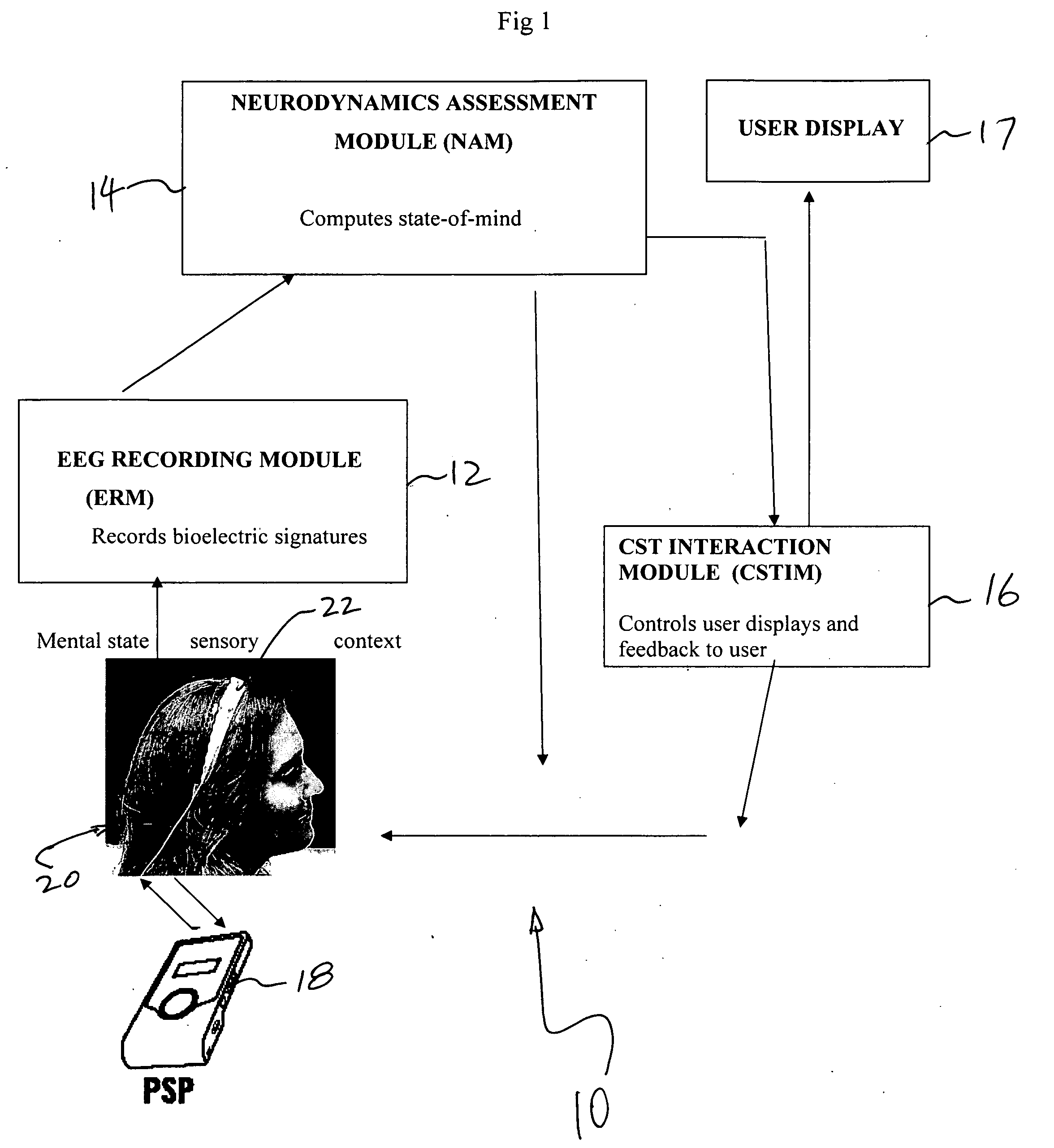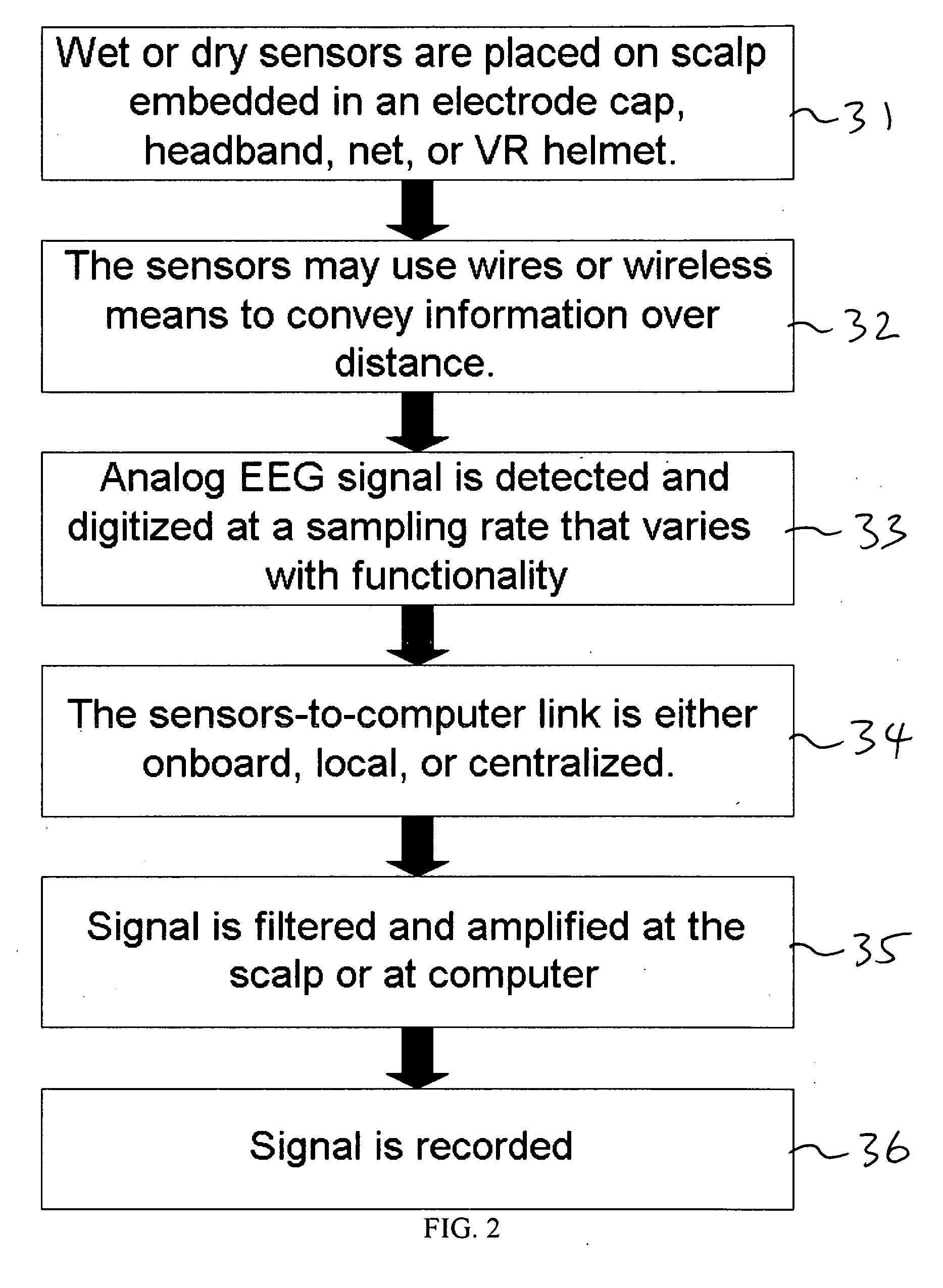[0015]The present invention relates to a system and method for adaptive therapeutic intervention to effect real-
time changes in the behavioral profile of an individual to facilitate the effectiveness of combined bioelectric sensing and biosensory based therapy for specific disorders. The present invention comprises a system and method for inducing a temporary physiological state-of-mind (e.g., increased relaxation) to effect persistent changes to the cognitive-emotive profile of the individual (e.g., reduce internal tinnitus). Capable of rapidly recognizing the functional significance of the mental and
brain function, the invention represents a unique approach to
neurofeedback and “mental-state” therapy. The invention makes possible sensitive management of types and levels of therapeutic and non-therapeutic interventions. The sense- and
mental state-awareness responses, integrated into a two-way (i.e., bi-directional) feedback system using a
dynamic interface with intelligently controlled thresholds. The invention takes into account details of multi-variate and nonlinear dynamics and
database templates to more accurately compute the user's “state-of-mind.” It then utilizes this “state-of-mind” to drive therapeutic and non-therapeutic stimulus intervention. By way of a “combinatorial stimulation sequence” approach that uses customized sounds, the present invention creates a fine-tuned and well-controlled process. The significance of this interactivity is a prolonged change in the individual's cognitive-emotive profile.
[0016]In one aspect, the present invention relates to a system and method for adaptive therapeutic intervention to effect real-time relaxation changes in the behavioral profile of an individual to facilitate the effectiveness of customized
sound therapy for specific central auditory processing disorders. In particular, this aspect of the invention relates to a system and method that involve the use of
neurofeedback techniques using bioelectric fields and characterization of bioelectric activity for producing real-time, adaptive changes in the behavioral profiles of individuals while undergoing customized
sound therapy for a variety of disorders. It combines recently developed advances in neurophysiological techniques into a system suitable for real time adaptive therapy that will enhance wellness, speed up and improve the quality of care, and minimize intervention for specific disorders such as
chronic fatigue, pain, tinnitus, depression, sleep disorders,
addiction,
anxiety, post traumatic
stress syndrome,
obsessive compulsive disorder,
eating disorders, motor skills disorders, communication disorders,
attention deficit hyperactivity disorder,
autism, dissociative disorders, and
impulse control disorders.
[0019]In one embodiment, a personal sound player (PSP) is used in the present invention to provide an
intelligent control interface to monitor,
record, and transform bio-signals, as well as interact with built-in
software implemented processes for customized
sound therapy. The interface comprises means for acquiring the bioelectric signals of a user, which are converted into a digital
stream, processed and combined to define a cognitive-emotive profile as well as a “state of mind” of the user. This cognitive-emotive profile is used to drive the relaxation
neurofeedback and interact with the customized sound therapy. Incorporating
microprocessor-based
software and
database capabilities, the interface dynamically maps the cognitive-emotive profile onto multiple functions, which are adaptable for actuating
microprocessor commands. In conjunction with other standard input devices such as mouse, keyboard, or
joystick, the
intelligent control interface of the present invention provides a user with control over the sound experience that may be creating problems.
[0020]In addition to providing such control the interface is adaptable to wirelessly map bioelectric signals into
microprocessor commands in real time. It further enables closed- and open-loop feedback without the need for the constant monitoring of the input. The invention incorporates adaptive
pattern recognition functions (e.g., by way of a
software implemented module) that allow for
automated learning, whereby the system learns to recognize a user's specific cognitive-emotive profile, as it changes over time. It handles spontaneous EEG rhythms, particularly those measured over the sensorimotor cortex, time-locked responses to external events, or event-related potentials (ERPs),
steady state visual evoked responses in a rapid, bi-directional way, as well as autonomic measures of bodily states (e.g., HR, GSR, and EOG). The device enables the user to learn to control the magnitude and effect of bioelectric signals and to do so within a short period of time. By controlling these signals, for example, in producing or blocking them, the user can dynamically alter levels of
anxiety and stress that make customized sound therapy more effective.
[0021]In one embodiment, the PSP device is structured and configured to provide a mapping function, which is comprised of inputs from various types of bioelectric signals that are recorded. A combinatorial software implemented function captures the interdependencies among the signals, which are then associated with the particular microprocessor commands. The extracted
signal obtained from the user can be analyzed and used for control in a variety of ways. For example, the different dimensions of the
signal can be decomposed, analyzed, and configured with respect to normative patterns in a database. Further, individual differences in baseline levels and in the degree of control that users learn to exert over their own signals can be analyzed and resolved by the learning module (e.g., algorithms). The result is a highly adaptive capability of the present system that can be refined over time.
 Login to View More
Login to View More  Login to View More
Login to View More 


